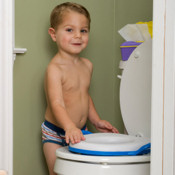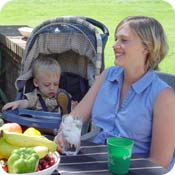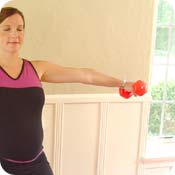 Sometime in the first year of your first child's life, you'll start thinking longingly of potty training.
Sometime in the first year of your first child's life, you'll start thinking longingly of potty training.When your 1-year-old shows some interest in what you're doing in the bathroom, you go out and buy a kid's potty thinking you have a toilet prodigy only to find they have no intention of using it. In their second--and maybe, third--year, you lose hope. Then suddenly, potty training happens. Just when you've resigned yourself to cleaning up messy bottoms and carrying a diaper bag forever, you're free. He's peeing on the potty! But your celebration is cut short when you discover, as you will over and over again after having kids, that any new skill brings a new set of challenges. You might realize this the first time you have to take your newly potty-trained child to a public restroom. I already covered some of the difficulties there: germs, scary flushes and too-high sinks. But there are other perils of potty training. Your child might not stay dry at night. It's normal for newly toilet-trained children to not be able to stay dry at night. Expect to use training pants at night and during naps for a while, if you can. (My son rejected them as diapers about two weeks into being potty-trained.) If you can't, get a plastic cover to protect the mattress and expect to do a lot of laundry. Don't make a big deal about the accidents, but be honest about what's happening and do your best to prevent it by limiting liquids before bedtime. My own kids don't get anything after dinner. Also, make one last bathroom stop a part of your bedtime ritual. Some school-age children will continue to have accidents at night. The American Academy of Pediatrics, in addition to the advice I offered above, suggests having the child help change their wet sheets--not as punishment, but to teach responsibility--and rewarding dry nights without punishing wet ones. Instituting a no-teasing policy inside the house, especially if you have older kids, is a good idea. There are medications that, though they won't completely fix the problem, can help children for special occasions such as sleepovers. Your potty-trained child might not poo on the potty. Some kids have a hard time having a bowel movement anywhere but their diapers. If it takes a little longer to get that resolved, don't fret. Stay positive. You want you child to want to poo on the potty. You don't want him to fear it. If that happens, he might start holding his stool, thereby causing it to harden to the point where it hurts both before and after he finally goes, making him not want to do it again--and starting a cycle that can be hard to break. Remember: A lot of this is about control, according to the American Academy of Pediatrics. Kids can't control much, but they can control when they go to the bathroom. If they're feeling stressed--about potty-training or about something else--their response might be to control what they can. Your (mostly) potty-trained child might have accidents. Many kids just don't think about having to go. I know my own son often was so busy playing, he would forget to go until it was too late. So, offer the potty often. And, if you're having trouble with No. 2, offer it at times that he's likely to need to have a bowel movement. When accidents happen, don't yell or scold. Odds are the child knows this is not a great thing. Have him help you clean up and move on with life. Your potty-trained child can't really get himself clean. The sad truth is that even after they're potty-trained, you're still wiping bottoms. And sometimes, toilet paper isn't going to cut it. You can buy flushable wipes--several companies make them now--but I find that a wet baby washcloth or a regular old wipe thrown in the trash works just fine. It's not every single time, after all. And finally a few more public bathroom tips, including some submitted by our readers (thank you!):
|
Post Potty Training Pitfalls
Toilets and Toddlers: A Helpful Guide
Page 1 of 1






Member Comments